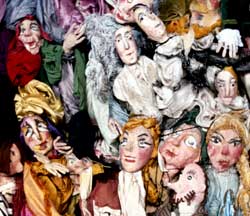
 Collezione Maria Signorelli
Collezione Maria Signorelli

Olga Resnevitch with Maria (standing) and Elena, Rome 1911

Invitation to M.Signorelli's first exhibition, Rome 1929

M. Signorelli with Tango Dancing Couple
from Die Puppen der Maria Signorelli,
"Reclams Universum" (leipzig), 11 02 1932

Her house in Rome: the drawing room

Maria Signorelli, Rome 1980
collaborators from 1947 to 1992
Born on 17 November 1908, Maria Signorelli was the eldest of the three daughters
of the Latvian writer (and doctor) Olga Resnevitch and Angelo Signorelli, who was
one of the first Italian radiologists.
From her earliest years Maria was keenly receptive of the wealth of fascinating impressions provided by her family circle and by the literary and artistic salon that
her father and, particularly, her mother (a devotee of the theatre and biographer of Eleonora Duse) held for many years in Rome, in their home.
After completing her classical studies Maria Signorelli enrolled at the Fine Arts Academy of Rome and began to frequent the set- and costume-designing studio
of the Royal Opera House, which was directed at the time by the Russian painter Nicola Benois.
Her passion for drawing, colour and the theatre led her to make her first puppets, a form of malleable sculpture, which were first exhibited in 1929 at the Casa d’Arte Bragaglia Via degli Avignonesi, in Rome.
After a second exhibition, presented by Giorgio De Chirico, at the Galerie Zak in Paris, she went to Berlin for a long stay which culminated in a new exhibition at the Galerie Gurlitt.
On her return to Italy she worked with director Anton Giulio Bragaglia on numerous plays that were produced in Rome at the Teatro degli Indipendenti and, later, at the Teatro delle Arti.
In 1934 together with Carlo Rende, she devised, “Pluriscenio M”, a stage design constructed so as to permit the simultaneous presentation of seven different scenes.
It was exhibited in Rome at the “Stanze del libro” and afterwards in other parts of Italy and in Buenos Aires, and was admired by Bragaglia and praised by the founder of Futurism Filippo Tommaso Marinetti.
In 1937, at the suggestion of the Swiss singer Maria Amstad, she created her first
La boîte à joujoux and Bastien et Bastienne were produced in Rome.
In 1939 she married the professor of pedagogy Luigi Volpicelli. Although she was immensely active as a set and costume designer during this period, it was only after the war, in 1947, that Signorelli founded her own company, L’Opera dei Burattini. Its productions, which soon appeared in rapid succession, boasted contributions from such distinguished artists as Lina Wertmüller, Gabriele Ferzetti and Scilla Brini (among the actors), Enrico Prampolini, Ruggero Savinio and Toti Scialoja (among the painter/set designers), Ennio Porrino, Vieri Tosatti and Roman Vlad (among the composers) and Margherita Wallmann and Giuseppe De Martino (among the directors).
Little by little a repertory was formed, aimed both at adults, who were attracted by the wonderfully poetical productions, and at children, for whom the puppets revealed a whole world of fable, which was not without its educational value as well. Some of her major shows based on literary works were King Stag (Carlo Gozzi), The Fable of the Little Goldfish (Alexander Pushkin), The Nightingale and the Rose (Oscar Wilde), The Tempest (William Shakespeare), Faust (Guido Bonneschk), Dante’s Inferno, The French Revolution (Guido Ceronetti) and Antigone (Bertolt Brecht), and there were many others.
Her particular genius for creating puppet-dancers and for moving them led to the fame of her ballets, such as Cinderella (to music by Sergei Prokofiev), El Retablo de Maese Pedro (to music by Manuel de Falla) and La boîte à joujoux (to music by Claude Debussy).
In addition to her constant work for the stage and the creation of hundreds of puppets - some of which show her delight in ingeniously simple and effective designs while others reveal elegant refinement - she dedicated herself to passing on the tradition, which involved, starting in 1972, teaching a course in puppet theatre that was set up expressly for her at the DAMS (the art, music and theatre faculty of the University of Bologna), and creating various radio programmes (including Moto perpetuo [Perpetual Motion], 1953-4; Giochiamo al teatro [What Do You Say We Put on a Play? ] (1967-68) and television broadcasts (such as Serata di gala al Teatro dei Burattini) [ A Gala Performance at the Puppet Theatre ], 1958; Piccolo mondo magico [Little Magic World ], 1959; Pomeriggio all’Opera [ An Afternoon at the Opera], 1960, among others), as well as working on lectures and articles in academic journals of educational theory.
Among the books she wrote are Storia e tecnica del teatro delle ombre [History and Technique of Shadow Theatre] (1981), Il Gioco del burattinaio [The Playful Art of the Puppeteer ] (1975) and Strumenti musicali fatti in casa [ Musical Instruments Made at Home] (1977).
Her passion for collecting gave rise to a great number of exhibitions, both in Italy and abroad, on puppet theatre throughout the ages. At the same time numerous exhibitions of her own creations were put on all over the world.
She was a member of the World Council of UNIMA (International Union of Marionettes), and she founded UNIMA-Italia and was long its Honorary President.
She died in Rome on 9 July 1992.
Maria Signorelli’s major exhibitions, both one-woman and collective, include Figurini plastici di Maria Signorelli [Maria Signorelli’s Three-Dimensional Figures ], Casa d’Arte Bragaglia, Rome (1929); Les fantocci de M. Signorelli [The Puppets of M. Signorelli], Galerie Zak, Paris (1930); Maria Signorelli Galerie Gurlitt, Berlin (1932);
Maria Signorelli Sala d’Arte de “La Nazione”, Florence (1933); 35º Esposizione degli Amici dell’Arte [35th Patrons of Art Exhibition] - Silver Medal -, Turin (1934); Exposición escenotecnica italiana [Exhibition of Italian Stagecraft] (curated by A.G. Bragaglia), Buenos Aires (1935); Mostra d’arte dei Littoriali [Lictorian Art Exhibition], Rome (1935); VI Triennale [6th Triennial Exhibition], Milan (1936); Mostra delle donne artiste d’Europa [European Female Artists’ Exhibition], Paris 1937
Mostra di figuriniste e scenografe [Female Set- and Costume-Designers’ Exhibition], Florence (1942); I Mostra internazionale di scenografia promossa dalla rivista “Teatro” [ 1st International Exhibition of Theatrical Design sponsored by the journal “Teatro”], Rome (1946);
Mostra di scenografia italiana [Exhibition of Italian Theatrical Design], Bern (1947); Triennale [Triennial Exhibition], Milan (1951); Scenografia italiana all’estero [Italian Theatrical Design Abroad] (curated by Enrico Prampolini), Brussels (1951); I Mostra Arti Figurative Artiste Contemporanee [1st Exhibition of the Figurative Arts by Contemporary Female Artists], Rome (1958).
Among the principal exhibitions curated by Maria Signorelli in which she
exhibited items from her personal collection, and occasionally items she herself had made, are Burattini e marionette oggi a Roma [ Hand Puppets and Marionettes in Today’s Rome], Fondazione Besso, Rome (1960); Burattini e marionette [ Hand Puppets and Marionettes], Castello Cinquecentesco, L’Aquila, Italy (1961); Burattini e marionette italiani [Italian Hand Puppets and Marionettes], Museo Teatrale alla Scala, Milan (1967); Burattini e marionette [Hand Puppets and Marionettes], Fondazione Besso, Rome (1970); Tra il vecchio e il nuovo [Half Old, Half New], Teatro Goldoni, Venice (1975); V Mostra di marionette e burattini [5th Exhibition of Hand Puppets and Marionettes], Palazzo Strozzi, Florence (1977); Burattini e marionette in Italia dal Cinquecento ai giorni nostri [ Hand Puppets and Marionettes in Italy from the 16 th Century to the Present Day ], Palazzo Antici Mattei, Rome (1980, and in New York, 1982); Tra marionette e burattini. Itinerario magico nella civiltà veneta [Amidst Marionettes and Puppets. A Magical Cultural Tour of the Veneto], Palazzo della Gran Guardia, Verona, Italy (1983); Il teatro delle ombre [Shadow Theatre], Castello dei Pio, Carpi, Italy (1983);A filo di mani. Mostra storico-documentaria [Hanging by a Thread. A Historical Exhibition], Villa Foscari Widmann, Mira, Italy (1985).
Among the principal exhibitions curated by G. Volpicelli (unless otherwise indicated) are A Half Century of Puppets , Louis Abrons Arts Center, New York (1991); Maria Signorelli. Teatro, marionette e burattini [Maria Signorelli. Theatre, Marionettes and Puppets] (curated by M. Giufré), Fortezza Firmafede, Sarzana, Italy (2000);
A Half Century of Puppets. The Magic Art of Maria Signorelli , New Muslim Town, Lahore, Pakistan (2000, and in Istanbul, Turkey, 2001 and Jywaskjlä, Finland, 2002); Maria Signorelli. Mezzo secolo di burattini [Maria Signorelli. A Half Century of
Puppets ] Museo Internazionale delle Marionette “Antonio Pasqualino”, Palermo, Italy
(2001); Un mondo di bambole [A World of Dolls], Palazzo Rospigliosi, Zagarolo (2001); Burattini per giocare [Puppets Play], Palazzo Rospigliosi, Zagarolo, Italy (2002); Piccoli personaggi grandi incanti [Little Characters, Great Charms], Palazzo dei Trecento, Treviso, Italy (2002); Il Teatro delle Meraviglie [Theatre of Wonders], Teatro Studio San Floriano, Jesi, Italy (2003); Le dame, i cavalieri, le armi, i castelli [Knights, Ladies, Arms and Castles], Palazzo Rospigliosi, Zagarolo, Italy (2003) Maria Signorelli Ballets, Museum of Puppetry, Lahore, Pakistan 2004.
-Magico Teatro [Magic theatre], Università Donghua, Shanghai 2004; Marionette Genovesi del XIX sec. Palazzo Rospigliosi,Zagarolo,2005; Magico Teatro [Magic Theatre], Sala S.Rita, Roma,2006; La Fabbrica dei Sogni [The factory of dreams], Casa dei Teatri, Roma, 2006. Burattini Giramondo [Puppets around the world], Palazzo Rospigliosi, Zagarolo 2006.Magico Teatro [Magic Theatre], Istituto Italiano di Cultura Zagabria, Croazia 2006.